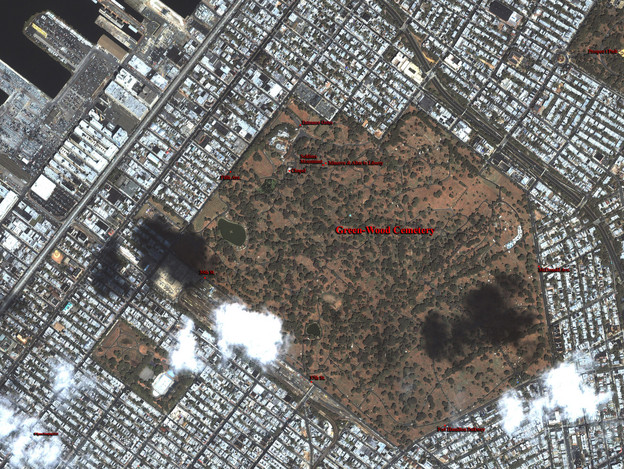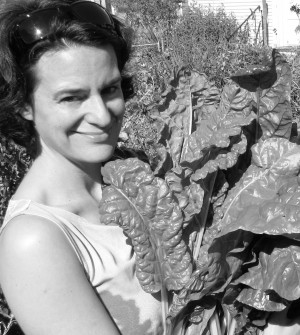Poetry, politics, and perambulation
A conversation with Allison Cobb

Jules Boykoff
Allison Cobb is an innovative culture worker who deftly blends rigorous research with a poetic sensibility to create thought-provoking writing. Her interdisciplinary, cross-genre book Green-Wood (Factory School, 2010) is a prime example of her ability to write complex texts that weave together personal narrative, political history, and environmental considerations. This book draws from scholarly research on the Green-Wood Cemetery in Brooklyn to open up the field of inquiry to wider social processes—such as war, death, and life—and personal experiences—such as attempting to have a child with your partner. This book, which expertly flings socio-political history through the discriminating filter of Cobb’s agile mind, also demonstrates her adeptness at writing both verse and prose. She lives in Portland, Oregon where she is at work on a new book-length project, The Autobiography of Plastic.
Recently I had the good fortune of engaging in conversation with Allison about the role walking plays in her work, how space matters, and why she concertedly pushes for the relevance of poetry in the instant-gratification-is-too-damn-slow zeitgeist.
JB: A number of poets whose work I admire have engaged walking as a vital dimension to their composition and thought processes from Kevin Varrone’s perambulations in Philadelphia that helped fuel Passyunk Lost to Kaia Sand’s walking in North Portland that led to her book Remember to Wave. What role did what Sand calls “pedestrian poetics” play in your writing process for Green-Wood?
AC: I actually started out walking in Green-Wood, not writing about it. I walked in the cemetery for exercise, and because it was there--500 acres of open space, the largest in Brooklyn, right across the street. Then, because as I was walking, my eyes were open, I started noticing things about the cemetery. And then I started getting interested in it. And then I started reading about it. And then I started writing about it. Or writing through it.
Later, when Green-Wood had become more of a conscious "project," my interactions with the cemetery were still always centered around walking. I found that after walking over and through the hilly terrain for about an hour, after getting into the meditative rhythm of walking, I became a much better observer. I got more attentive, more still. I could get kind of emptied and just let what I was seeing or experiencing fill me. I started to get a kind of ecstatic feeling. Not the endorphin high of intense exercise, but more like a meditative, rhythmic, walking high. A “what amazing thing is going to happen next” kind of high. Sometimes, many times, the thing that happened was kind of small. Like a massive spider web anchored to an old elm on one side and to the hem of the robe on a statue of Jesus on the other side. Or a sparrow stabbing with its beak at a big cicada, which kept rolling away from it in the wind. Things that took being still, and noticing, and attention to experience. But I couldn't just go and plunk myself down on a bench somewhere and start noticing things. I needed walking to sort of “arrive” there, mentally.
I wonder if that kind of experience, and that calm euphoric feeling, were more common when walking as a way of getting places was more common. Driving is about transiting through, getting somewhere else. The speed of driving obviously means you notice less. And for me driving is never calming. It's tension-inducing or boring, because it's monotonous. You are always surrounded by the same interior environment of the car, whereas walking, it seems to me, is both about transiting and experiencing, and it's always different. I often took the same or a similar route through the cemetery, I developed a bit of a habit about it. But my experience of it was always so different.
JB: Your remarks harken to something Gary Snyder once wrote, “There’s all sorts of walking—from heading out across the desert in a straight line to a sinuous weaving through the undergrowth.” Sounds like the latter path better describes your writing process: “a sinuous weaving through the undergrowth.” But clearly for your poetic practice, space matters. What were your social experiences like in terms of the production of space when walking in Green-Wood Cemetery? Mustafa Dikeç gets at this when he describes “the spatialization of the Other” by which he means “depriving the inhabitants of certain areas of their rights to the city in the political sense of the term.” Where did you see political power exerted within the wrought-iron fences of Green-Wood?
AC: I saw political power exerted everywhere in Green-Wood, both from within the wrought iron fence and without. As I mentioned, the cemetery is the largest open space in Brooklyn—at 500 acres it is more than half the size of Central Park, and similar in its features—with tree groves, lakes, hills, and a ridge overlooking the city. In fact, Green-Wood served as a model for Central Park. But the cemetery is private property, not public. That gives this space an entirely different existence. In some cases, as far as the public is concerned, it disappears.
For example, the cemetery is surrounded on all sides by working-class (though gentrifying) communities of apartment buildings and row houses, with little in the way of parks or public space immediately accessible. Outside my apartment building, the neighborhood kids hung a basketball hoop from a parking sign and played in the street. They played yards away from 500 acres of open space, but because they weren't allowed there, it basically didn't exist for them.
The cemetery disappeared altogether from public use during the 20th century. Until the 1990s, only people who owned lots (property owners) could enter. I felt the vestiges of that policy whenever I went into Green-Wood. I wasn't a worker or someone grieving or a lot owner, and I wasn't dead. I didn't fit any of the definitions of an individual with a legitimate "right" to be there. This sense was reinforced by the mechanisms of control always visible in Green-Wood--the razor-wire topped fences and security guards patrolling the grounds. Once, in the six years I visited Green-Wood almost everyday, I sat down in the grass by one of the ponds. A security patrol car passed by within minutes; the guard asked me not to sit on the ground. Because it is private property, the cemetery defines who belongs to the space and who is other, and how those within the space can behave.
On the other hand, as a private property owner, Green-Wood has a wide latitude to behave however it wants. I literally wandered into this fact of law when I began encountering the pesticide sprayers in the cemetery. They blanketed the grounds with pretty nasty chemicals every spring and fall. I accidentally got caught in this spraying a few times--quite an unpleasant experience--so I began looking into it. I found that the cemetery was spraying chemicals that had been banned on public property in New York—Central Park, for example—because of health concerns. But they remained perfectly legal for a place like Green-Wood.
Still, Green-Wood's control is not total, and never has been in the 160 years of its existence. I was fascinated by that tension—between the power codified in law to "own," create and control a space, and the practical impossibility of ever achieving that control.
One small example is weeds. Defined as anything not wanted, weeds are always spatialized as Other. Whatever the health and nutritional properties of dandelions, they belong "over there," not "here." Green-Wood aimed to keep weeds out by spraying those chemicals, but the fast-growing colonizers absolutely flourished in that landscape, as they will in any disturbed (i.e. regularly mowed) area. Imagine keeping weeds out of 500 acres of grass. Weeds, both literal and figurative, have invaded Green-Wood since before its founders opened the gates.

JB: Changing gears a bit, for a long time you worked with the Environmental Defense Fund and you have continued to do environmental work since coming to Oregon in 2008. How does this environmental work inflect Green-Wood?
AC: Hmm. I think Green-Wood may have turned me into an environmentalist, rather than the other way around. I had worked for Environmental Defense Fund for a number of years as a writer and editor, but I didn't really have that much interest in natural systems. In truth, it was a bit of an accident that I worked for EDF. But Green-Wood (and this is another thing its founders hadn't planned) became this haven for wildlife in the city. I came face-to-face with egrets and night herons and red-tailed hawks. I couldn't avoid them. Then, I had the privilege to befriend some birders who frequented Green-Wood, and they taught me to appreciate all the birds that flowed through the cemetery. I began, for the first time in my life, to experience the natural rhythms of a place, how it changed with the seasons. I expected the egret in August, and the hawks around November. Hawk nesting in March. Frogs in summer. The snapping turtles too. Baby ducks and geese in the spring. Working for an environmental organization certainly heightened my awareness and knowledge about issues like global warming and gave me a frame for thinking about my encounters in Green-Wood. But I felt the experience of the place in my body. There was a deep joy in that sense of feeling connected to a place. That's why it was painful that my relationship to Green-Wood was so tenuous, because of its status as private property.
JB: In a recent book review you wrote for Aufgabe you described being frustrated by a poet in New York who aggressively asserted poetry’s futility in a way that shut down aspiration, foreclosing hope. You wrote, “I wasn’t that ready to deny my own relevance” and I read that statement as a refusal to write off the possibilities of poetry. Could you please elaborate on what you meant?
AC: Well, I think I need to believe in the possibilities for poetry in order to continue writing. I certainly wouldn't want to overstate our relevance as writers either, though. As we know experimental poets and writers are usually disregarded. But if we accept that language to a large degree creates reality, then certainly all writers have a part to play in that, even if, you know, only five people are reading. I think poetry and experimental writing can have some small effect just by disrupting the seemingly endless, seemingly logical flow of information that bombards us.
I was just talking about this to my friend the poet Jennifer Bartlett. Much of Green-Wood is written in a sort of historical prose. I was telling her what a strange voice that was to write in, how artificial it felt. But the book flips in and out of that voice, switching to lines of lyrical poetry, lists, etc. It was my hope that disrupting that authoritative voice would reveal it as constructed, as a “pose.” In another context, you might read a book of history (and I read many in researching Green-Wood) that never removes its mask, that never violates its own genre conventions. It acts like it's delivering “facts” without any sense of struggle around that concept. I'm much more interested in writing that violates the “rules”—of poetry, of prose, of nonfiction. That kind of writing, to my mind, asks readers to think in new ways about information and meaning. Maybe it even suggests possibilities for a different kind of reality.
Sources
Gary Snyder, The Practice of the Wild (San Francisco: North Point Press, 1990), p. 113.
Mustafa Dikeç, “Police, Politics, and the Right to the City,” GeoJournal 58 (2003), p. 93.
Moxie politik